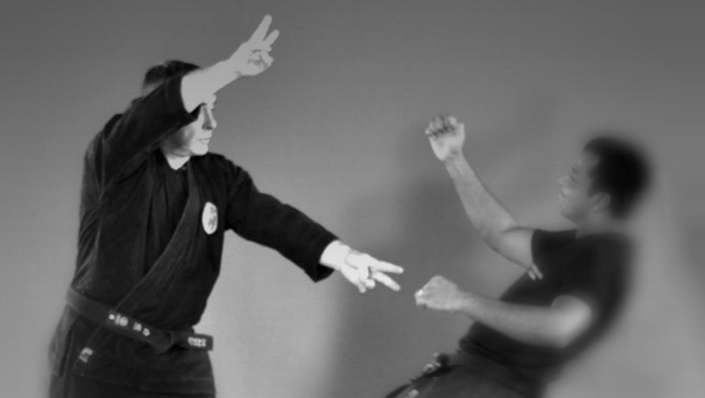
Theme 2005 - Kasumi no Hō
In 2005 Sensei taught the concept of “Kasumi no Hô” (霞の方) - having the perception we are fighting in the fog, and I must say that my training partners and myself were totally in tune with this idea…
If I had to define in three words what we did I would say:
Ikken Hassô (Shinden Fudô Ryû):
This is taken from the first level of Shinden Fudô Ryû and means “one fist, all directions” but I prefer the idea of “unity within multiplicity” which gives a deeper meaning to it. In fact, it would be difficult to explain what Sensei is demonstrating. The only thing that can be repeated and again is "no force, no tension, no intention, no idea."
Demonstrating the Kasumi no Hô concept, it was as if he was creating a fog that would trap the uke and render them blind to whatever was happening to them. I have been uke a few times and it is like is “not there, but there” as Pedro said once. You are totally lost.
The techniques were demonstrated by various Shihan and Sensei would “change” (see previous posts) the form into a formless thing. After the day of training with my partners, I had no memory of what we actually did. Day #1 was “totally fogged”.
Tôtoku Hyôshi:
In the afternoon, Sensei played with the concept of Tôtoku Hyôshi that we know from Biken Jutsu (for the newcomers this is the one were from Suwari, you dodge the shuriken with your blade facing flat and vertically the opponent). As you can see below; the “Tôtoku” has the meaning of "shielding yourself with the sword."
Sensei used this concept explaining that the warriors in the past (possibly at the beginning of 17th century, after peace was established, and Yoroi abandoned), had metal rods along the forearm and that you could dodge a cut by putting the forearm in front of you.
Everything is a question of timing (Hyôshi), and your shielding with the vertical forearm comes at the right moment. This Tôtoku Hyôshi not only protects you but gives away Uke’s balance.
Shitakara:
This last concept was detailed after we trained the Tôtoku Hyôshi for some time. Many of us were more reacting with the arm instead of the body even though Sensei insisted a lot on using the Karada (body) in every move done.
Shitakara (from below) is the way you would unfold the twisted body resulting from the Tôtoku Hyôshi reception. As you know in Tôtoku Hyôshi you give your profile to the opponent. Here due to the distance, once you have blocked/dodged the attack, your body is twisted. Untwisting the body to finish uke has to come from the ground. The grabbing is not allowed as well as the simple upper torso movement.
What Sensei explained during this first day of DKMS is that to show no strength and no intention you should only react with aruki waza (walking). The movement must come from the legs, to get the upper body into action.
The theme this year was to use the fingers and to trap the fingers of the opponent. This action must be supported by the body movement and not be decided by your brain.
Natural movement is achieved when you react softly to uke’s movement without deciding what to do. “Chikara o Nuku”: by letting go of all the force you have, you create the conditions of becoming aware of the next step, always in tune with your environment, with the attacks (from one or more opponents) and with the distance.
Anyway, the Gogyô are created from the ground (Chi) and go up to the sky (Kû). The "Tenchi" is replaced by the "Chiten", a "point".
Ikken Hassô, then, makes a lot of sense, as one can deal with an infinity of situations.
Every point of the universe converges to one. And unity is zero.
Course Curriculum
Kasumi - Part I
Available in
days
days
after you enroll
-
StartKasumi - Introduction (2:46)
-
StartKokū 1 Expression 1 (3:32)
-
StartKokū 1 Expression 2 (1:47)
-
StartKokū 1 Expression 3 (1:24)
-
StartKokū 1 Expression 4 (1:38)
-
StartKokū 1 Expression 5 (1:34)
-
StartKokū 1 Expression 6 (4:09)
-
StartChō Kankaku Expression 1 (3:28)
-
StartChō Kankaku Expression 2 (2:40)
-
StartBō Expression 1 (3:29)
-
StartBō Expression 2 (1:18)
-
StartBō Expression 3 (1:31)
-
StartBō Expression 4 (1:58)
-
StartBō Expression 5 (1:06)
-
StartBō Tenchijin Sansai no Hō (2:45)
-
StartKaeshi Waza (4:14)
-
StartTaijutsu 1 Expression 1 (3:58)
-
StartJūmonji (2:02)
-
StartKokū 2 A (4:34)
-
StartKokū 2 B (1:32)
-
StartBiken Expression 1 (1:25)
-
StartBiken Expression 2 (4:21)
-
StartShotō Expression (1:49)
-
StartHanebi 1 (4:12)
-
StartHanebi 2 (1:11)
-
StartKuki Nage (1:48)
Kasumi - Part II
Available in
days
days
after you enroll
-
StartTaijutsu 2 Expression 1 A (4:22)
-
StartTaijutsu 2 Expression 1 B (4:02)
-
StartTaijutsu 2 Expression 2 A (4:07)
-
StartTaijutsu 2 Expression 2 B (2:14)
-
StartUnjaku (1:02)
-
StartSword Expression (2:08)
-
StartTaijutsu 3 Expression 1 A (4:32)
-
StartTaijutsu 3 Expression 1 B (5:34)
-
StartBō Unjaku 1 (4:35)
-
StartBō Unjaku 2 (3:49)
-
StartBō Unjaku 3 (3:10)
-
StartKodachi Expression (2:13)
-
StartMutō Dori 1 (5:08)
-
StartTaijutsu 4 Expression 1 (4:08)
-
StartBō Expression (3:14)
-
StartMutō Dori 2 (3:54)
-
StartTaijutsu 5 Expression 1 (0:49)
-
StartTaijutsu 5 Expression 2 (0:50)
-
StartTaijutsu 5 Expression 3 (0:55)
-
StartTaijutsu 5 Expression 4 (1:03)
-
StartTaijutsu 5 Expression 5 (1:15)
-
StartTaijutsu 5 Expression 6 (0:43)
-
StartTaijutsu 5 Expression 7 (1:14)
-
StartTaijutsu 5 Expression 8 (1:27)
-
StartSannin Dori (5:24)
-
StartJigoku Otoshi (1:50)
-
StartKasumi Conclusion (3:08)
